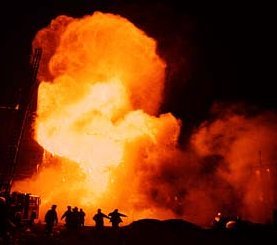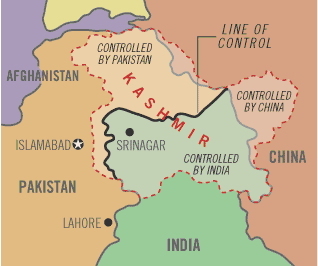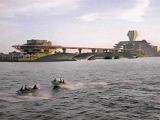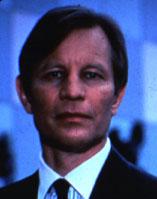Even with seaQuest back and at twice strength, the UEO fleet was still vastly outnumbered by Macronesian forces, four to
one in subfighters and two to one in DSVs.
As a result, the UEO began to investigate building a successor to the seaQuest class. Their first attempt, constructed in
2033, the seaHawk, lacked the necessary punch to make it a serious threat. Advanced Submersible Battleships were the next
step. The Capricorn class was the prototype for this new design. The most powerful ships ever built in terms of weaponry,
they were too unstable, and all six test craft were lost in 2036.
As Macronesian forces continued to encroach on UEO waters, the Alliance signed mutual defence treaties with the Chau-Di
Hegemony and the East Asian confederation. However, these treaties were merely a ruse to allow the Alliance to eliminate
their closest enemies. The Hegemony was completely subdued, while the East Asian confederation found itself partially
absorbed into the Alliance, with only China managing to remain somewhat independent (although ruled by a Macronesian puppet
leader).
The UEO turned once again to Nathan Bridger. Although retired, Bridger agreed to return in an advisory capacity. Along with
Lucas Wolenczak, and a Lieutenant Commander from seaQuest, Michael Warren, Bridger had designed a new class of Deep
Submergence Vehicles, designated �seaWolf�. Warren and Wolenczak also designed a series of advancements that would be made
to half of the original twelve planned seaWolf-class ships.
 The success of the seaWolf class became even more critical when, in 2037, Macronesian forces managed to avoid UEO patrols
and strike at UEO Atlantic Command (formerly UEO Headquarters) at New Cape Quest, leaving thousands dead. Although Bourne
condemned the attack as the work of a renegade faction within Macronesia, it is widely believed that he personally ordered
the assault.
The success of the seaWolf class became even more critical when, in 2037, Macronesian forces managed to avoid UEO patrols
and strike at UEO Atlantic Command (formerly UEO Headquarters) at New Cape Quest, leaving thousands dead. Although Bourne
condemned the attack as the work of a renegade faction within Macronesia, it is widely believed that he personally ordered
the assault.
In 2038, the first of the seaWolf class ships rolled off the production line. Designated DSV 6800, the UEO seaWolf was
universally praised as the best hope of stopping the Macronesian expansion. On her maiden voyage, the sub was sabotaged by
Macronesian operatives among the crew, and destroyed. Construction accelerated on the remaining subs, of which six had
already been scrapped because of budgetary concerns.
Another blow hit the UEO in 2038. While on patrol near the Macronesian border, seaQuest was attacked by Alliance forces,
the sub disabled and captured. In escaping captivity, Captain Oliver Hudson was killed during a firefight with Macronesian
cruisers.
 Many UEO members were now calling upon
Secretary General Thomas McGath to declare war against the Alliance, but even now McGath remains confident a peaceful
solution can be found.
Many UEO members were now calling upon
Secretary General Thomas McGath to declare war against the Alliance, but even now McGath remains confident a peaceful
solution can be found.
2039, and the first of the Advanced Submergence Vessels is launched. Under the command of one of its designers, Michael
Warren, UEO Excalibur ASV 7100 is commissioned amidst a blaze of controversy. Warren becomes the youngest captain in naval
history, at only 26. McGath counters the arguments by confirming his confidence in the young man, and giving him his full
support.
As tensions grow between the UEO and Macronesia, it is now only a matter of time until one side or the other makes the
decisive move�
 Increased fanatic nationalism in the late 1990s, accompanied by the chaotic events following September 2001, had led to
the development of large economic and military confederations, similar to the European Common Market, to cover the expense
of developing the necessary technology while maintaining a strong external defence. However, those confederations soon
grew increasing antagonistic towards each other, usually along pre-existing grievances, as well as clashes over rival
claims to mineral deposits. Pre-existing treaties were abandoned as the world�s geopolitical map changed every day.
NATO was wound up in 2005, as it broke up into confederations. The EU suffered a similar fate a mere six months later.
Increased fanatic nationalism in the late 1990s, accompanied by the chaotic events following September 2001, had led to
the development of large economic and military confederations, similar to the European Common Market, to cover the expense
of developing the necessary technology while maintaining a strong external defence. However, those confederations soon
grew increasing antagonistic towards each other, usually along pre-existing grievances, as well as clashes over rival
claims to mineral deposits. Pre-existing treaties were abandoned as the world�s geopolitical map changed every day.
NATO was wound up in 2005, as it broke up into confederations. The EU suffered a similar fate a mere six months later.
 With seaQuest temporarily out of commission, tensions once again rose in the UEO member confederations. The decision was
made to accelerate construction on the new seaQuest, and this much-improved design was launched on June 25th, 2021. After
resolving an assault on UEO Headquarters at New Cape Quest by GELFs (Genetically Engineered Life Forms � super-soldiers
created during the so-called �Dark Age of Genetics� in the early decades of the 21st century), the new seaQuest settled
down to another tour.
With seaQuest temporarily out of commission, tensions once again rose in the UEO member confederations. The decision was
made to accelerate construction on the new seaQuest, and this much-improved design was launched on June 25th, 2021. After
resolving an assault on UEO Headquarters at New Cape Quest by GELFs (Genetically Engineered Life Forms � super-soldiers
created during the so-called �Dark Age of Genetics� in the early decades of the 21st century), the new seaQuest settled
down to another tour. One of these confederations was the New Australia Confederation. In 2025, they held Presidential elections, which were won
by Alexander Bourne, an extremely charismatic and forceful politician. He immediately began consolidating his power, putting
his people in key positions. Shortly after he announced the confederation�s withdrawal from the UEO, Bourne staged a military
coup and took complete control of New Australia, dismissing the elected government.
One of these confederations was the New Australia Confederation. In 2025, they held Presidential elections, which were won
by Alexander Bourne, an extremely charismatic and forceful politician. He immediately began consolidating his power, putting
his people in key positions. Shortly after he announced the confederation�s withdrawal from the UEO, Bourne staged a military
coup and took complete control of New Australia, dismissing the elected government. The success of the seaWolf class became even more critical when, in 2037, Macronesian forces managed to avoid UEO patrols
and strike at UEO Atlantic Command (formerly UEO Headquarters) at New Cape Quest, leaving thousands dead. Although Bourne
condemned the attack as the work of a renegade faction within Macronesia, it is widely believed that he personally ordered
the assault.
The success of the seaWolf class became even more critical when, in 2037, Macronesian forces managed to avoid UEO patrols
and strike at UEO Atlantic Command (formerly UEO Headquarters) at New Cape Quest, leaving thousands dead. Although Bourne
condemned the attack as the work of a renegade faction within Macronesia, it is widely believed that he personally ordered
the assault. Many UEO members were now calling upon
Secretary General Thomas McGath to declare war against the Alliance, but even now McGath remains confident a peaceful
solution can be found.
Many UEO members were now calling upon
Secretary General Thomas McGath to declare war against the Alliance, but even now McGath remains confident a peaceful
solution can be found.